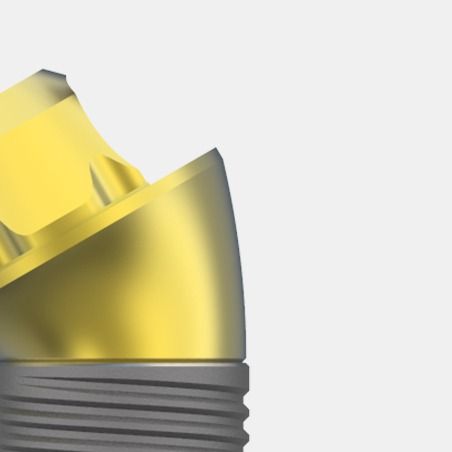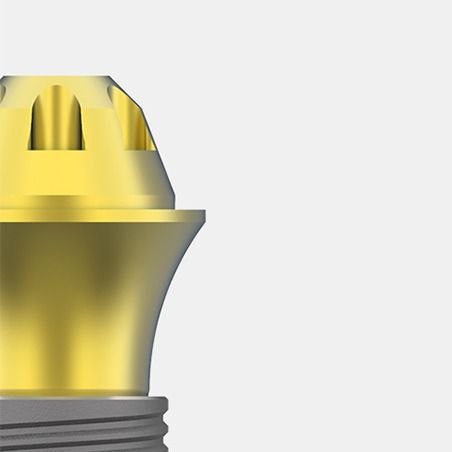
We are launching the new transepithelial abutments with a new emergency profile that facilitates aesthetic work.
Including abutments in your daily clinical practice can ensure the definitive success of the treatment.
But what advantages do they provide? How do they work?
Transepithelial or transmucosal abutments help us create a type of screw-retained prosthesis, allowing the connection of the prosthesis at the paragingival level, moving the micro-gap and the crown-pillar away from the osseous margin while restoring the biological width towards the apical, achieving an optimal mucosal seal.
It has the complete range of necessary attachments, as well as comfort caps, to protect the pillar during immediate loading.
The great advantage of transepithelial abutments is, above all, the comfort and safety when using the original pillars. There is no doubt that the precision in interventions is much greater when using this supplement, and the risks decrease. The results are well worth it.
Dr. Rafael García Rebollar
Transepithelial abutments are perfect for maintaining peri-implant health, essential for the overall success of treatment, thanks to the care of its three main axes: health, function, and aesthetics. For this reason, the importance of healthy tissue around the implant is essential. In the restoration of an implant, there is always a transmucosal component to ensure effective tissue sealing and protect the implant from the oral environment. This union is functionally similar to that of natural teeth but biologically different.

The new convergent emergency profile favors adaptation to the surrounding soft tissues, and its gold anodizing helps with mimetization.
According to the literature, the greatest peri-implant bone loss usually occurs during the first 6 months after prosthetic loading of the implants, after the invasion of the biological space, causing destabilization of the tissues and bone resorption, which can eventually expose the treated part of the implant to the oral environment and develop inflammatory pathology. Transepithelial abutments can be a key element in maintaining peri-implant health, reducing the risk of peri-implant diseases and improving the implant-prosthesis interface through the correct passive fit of the screw-retained prosthesis, making it perfect for immediate loading procedures.
Advantages
• Precision, versatility, and predictability.
• Balances platform heights and angulations.
• Improves prosthetic access and facilitates impression taking.
• Prevents excessive manipulation of tissues during the preparation phases of the final prosthesis.
• Preserves the structure of connective tissue, maintaining complete restorative and surgical flexibility.
• Forces work at the tissue level, being more comfortable for the patient and the clinician.
• Facilitates access for hygiene and maintenance tasks and simplifies routine care.
• Facilitates the positioning of prosthetic restoration.
• Its innovative “click” design improves the placement of transepithelial abutments in the mouth, allowing for a more precise impression technique for immediate loading.
If bone conditions are inadequate, the transepithelial provides the ability to correct angulation and height, thus adapting the prosthesis you want to place correctly and precisely.
Dr. Eduardo Duarte

Straight Abutments
Designed for optimal fit between the pillar seat and the implant connection for all types of Avinent connections. Highly recommended in multiple screw-retained restorations to raise the seating platform of the restoration according to the thickness of the mucosa in each patient. Straight pillars can be used in implants with a divergence of up to 17º.

Angled Abutments
The perfect solution when it is necessary to apply correction in the angulation of the treatment, varying the insertion axis of the prosthesis retention screw when, due to the position of the implant, the screw exit hole is not in a favorable position. Angled pillars include a screw that holds the transporter, ensuring correct use and offering the possibility of using the screw for the prosthesis in the definitive work. Angled pillars allow a divergence of up to 30 degrees.
The anti-rotational system of transepithelial abutments allows their use in both multiple and unitary prostheses. This system prevents any microrotation, thanks to the small grooves located on its surface.
We have found that after removing the connection after a long period, it remains impeccable. The fact that the connection is so precise is key to avoiding the leakage of bacteria that can lead to gum inflammation.
Dr. Juan Ferreira
If you want more information about transepithelial abutments with a new emergency profile, you can consult with your regular sales representative.